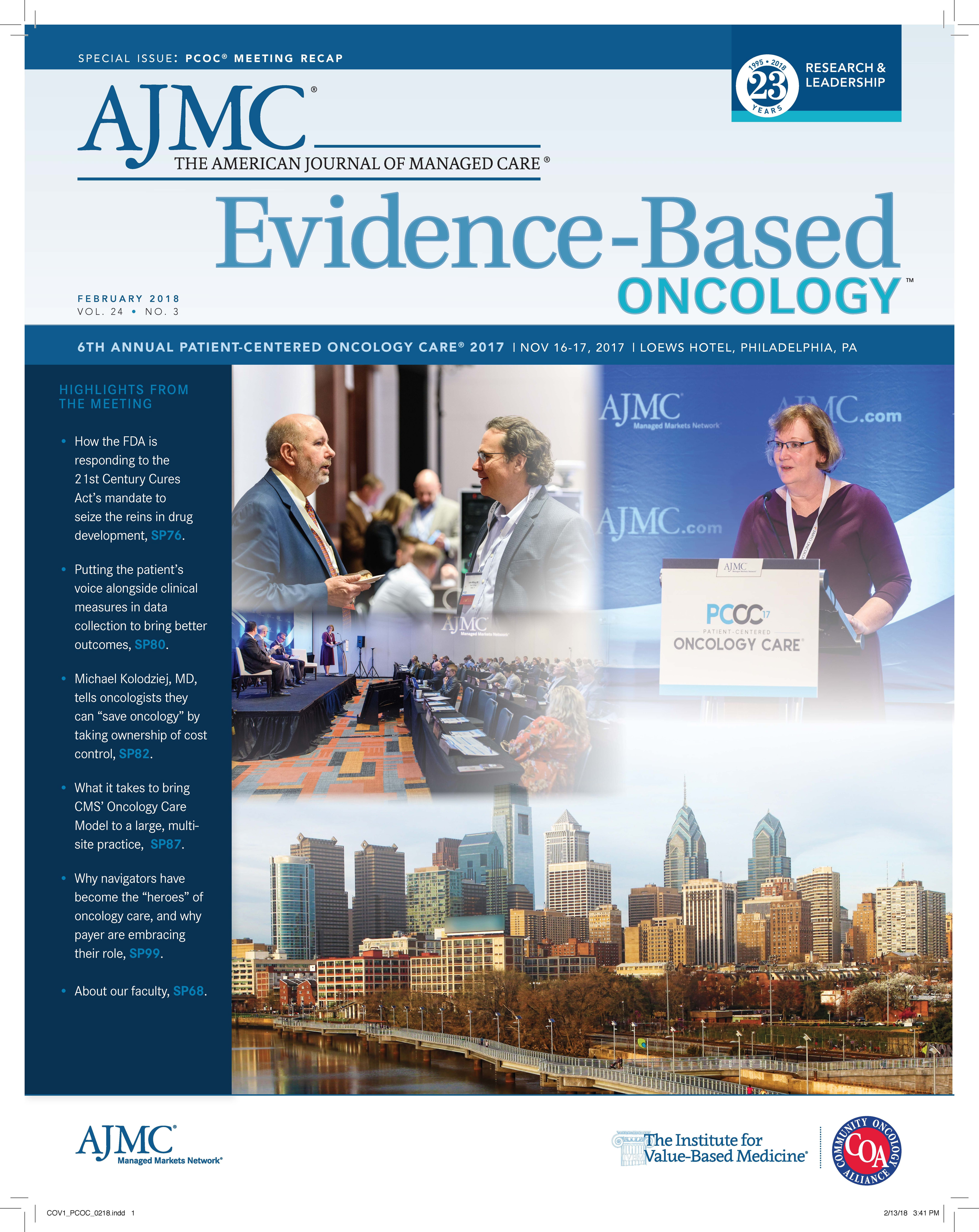Publication
Article
Evidence-Based Oncology
Oncologists Can Save Oncology if They Take Ownership of Costs, Kolodziej Says
Author(s):
Coverage of the Keynote Address from Patient-Centered Oncology Care, November 16-17, 2017.
IF ONCOLOGISTS ARE TO BRING INNOVATIVE treatments to the patients who most need them, they must confront their own role in escalating costs—and take ownership of the solutions, said a leading oncologist who has worn the hat of payer and technology leader.
“If oncology is going to get fixed, oncologists need to fix it,” said Michael Kolodziej, MD, ADVI’s vice president and chief innovation officer, who has worked recently for
Flatiron Health and spent 3 years at Aetna. Kolodziej was the keynote speaker at Patient-Centered Oncology Care®, the annual meeting that brings together stakeholders
across cancer care, presented by The American Journal of Managed Care®. The meeting took place November 16 and 17, 2017, at Loews Philadelphia Hotel in Pennsylvania.
Is the cost of cancer drugs a problem? Of course, Kolodziej said. But the decisions oncologists make are a big reason that US cancer care costs are on track to rise 27% to
$157.77 billion by 2020 from where they were in 2010.1 Kolodziej pointed to 3 pressure points: the cost of chemotherapy, poor end-of-life care (EOL), and unnecessary hospitalizations and emergency department visits. Oncologists can do more to impact all 3 by using patient-centered medical homes, embracing clinical care pathways, and encouraging better palliative and EOL care.
For all the innovation in cancer care, oncologists have hit a crossroads. Kolodziej showed a photo of the gas lines in the 1970s and likened oncologists to the Detroit, Michigan, auto industry of that era: Refusing to change is not an option, he said. He then featured a slide of Kymriah, the first approved chimeric antigen receptor (CAR) T-cell therapy, developed just a few blocks from the meeting site at Penn Medicine.2 For pediatric patients with acute lymphoblastic leukemia (ALL), Kolodziej said, “this is transformative.”
He described the old way of thinking: “The doctor might say, ‘Why don’t I just give it to everybody with ALL?’ It’s not that the doctor is wrong. It’s just that the game has changed.” Kolodziej understands that thought process. “We come from a time when we had so few therapeutic choices and were willing to try anything,” he said.
But today, oncologists have many choices—and that’s part of the problem, he said. Unnecessary variation helps drive up costs, leading to the rise of clinical pathways to guide care based on the best evidence available.
For oncologists who don’t like pathways, Kolodziej was blunt: Quit complaining.
And rein it in even further, he said: “Stop complaining about pharmaceutical companies that are just trying to get a return on their investment.”
Embracing change will give oncologists the ability to connect the right patients with CAR T-cell therapy, even though “it costs more than most of your houses,” he said.
Team-based care, early use of palliative care, and better use of EOL care not only reduce hospitalization and save money but also lead to better experiences for patients, Kolodziej said.
Despite all the advances in cancer care, some patients will not be cured, and oncologists must help these patients manage their disease so they have the best quality of life
for as long as possible. That may mean having different conservations from those in the past.
Although patients typically won’t bring up EOL care when they are first diagnosed, they know what they don’t want. In 2010, 28% of cancer patients spent time in the intensive care unit (ICU) in the last month of life.3 Although oncologists might be unsure about what patients want, Kolodziej said, “none of them said, ‘I’d really like to spend time in the ICU before I die.’”
Kolodziej then reviewed evidence from the COME HOME project4 and other efforts to reduce costs, noting evidence from the University of Alabama at Birmingham that found pairing patients with lay navigators dramatically reduced costs.5
Some oncologists might not like pathways or medical homes or be reluctant to promote good end-of-life care, but the arrival of changing reimbursement structures and Medicare’s Oncology Care Model will compel change. “Every one of these practices is going to be doing this math,” Kolodziej said.References
1. Mariotto AB, Yabroff KR, Shao Y, Feuer EJ, Brown ML. Projections of the cost of cancer care in
the United States: 2010-2020. J Natl Cancer Inst. 2011;103(2):117-128. doi.org/10.1093/jnci/
djq495.
2. FDA approves personalized cellular therapy for advanced leukemia developed by University
of Pennsylvania and Children’s Hospital of Philadelphia [press release]. Philadelphia, PA:
Penn Medicine; August 30, 2017. pennmedicine.org/news/news-releases/2017/august/fdaapproves-
personalized-cellular-therapy-for-advanced-leukemia. Accessed December 11, 2017.
3. Goodman DC, Morden NE, Chang CH, Fisher ES, Wennberg JE. Trends in cancer care near the
of life. The Dartmouth Atlas of Health Care website. www.dartmouthatlas.org/downloads/
reports/Cancer_brief_090413.pdf. Published September 4, 2013. Accessed November 16, 2017.
4. Colligan EM, Ewald E, Ruiz S, Spafford M, Cross-Barnet C, Parashuram S. Innovative
oncology care models improve end-of-life quality, reduce utilization and spending. Health Aff
(Millwood). 2017;36(3):433-440. doi: 10.1377/hlthaff.2016.1303.
5. Rocque GB, Pisu M, Jackson BE, et al. Resource use and Medicare costs during lay
navigation for geriatric patients with cancer. JAMA Oncol. 2017;3(6):817-825. doi: 10.1001/
jamaoncol.2016.6307.







